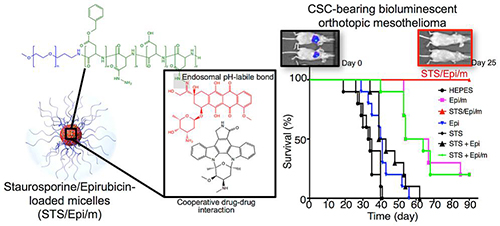Research Highlights
Vol.7, July 2016
Cooperative action of encapsuled drugs in nanomedicine enhances killing effects on drug-resistant cancer
Exploiting the interaction between drugs encapsulated in nanomedicine carriers could be an effective approach against drug-resistant cancers, according to a collaboration of researchers in Japan. Their studies in vitro and in vivo demonstrate that combining the drugs staurosporine and epirubicin in a pH-sensitive micelle carrier led to significantly greater decrease in drug-resistant tumour cells and an increase in survival in a mouse model.
Kazunori Kataoka and colleagues at the Innovation Center of NanoMedicine, the University of Tokyo, Kyushu University and the Tokyo Institute of Technology tested the micelle-encased drug-combo nanomedicine on malignant mesothelioma, an aggressive cancer characterized by recalcitrant cancer stem cells (CSCs), which are linked to metastasis, treatment resistance and eventual relapse of the disease.
Staurosporine is a known strong inhibitor of the protein kinase, and as a result inhibits a number of pathways integral to CSCs. The drug epirubicin is cytotoxic and has been encapsulated in micelles previously to provide targeted delivery to tumours. However some cancer cells are resistant to epirubicin. Encapsulating staurosporine with epirubicin provided a multitargeted attack on CSCs that suppressed a number of mechanisms for drug resistance in tumours.
In addition encapsulating the drugs in the micelle prevented exposure to healthy cells. The drugs were not released until the micelle disintegrated in the low pH environment of endosomes – a membrane-bound compartment in cells where internalised material is sorted before being degraded.
Fluorescence studies showed a decrease in the fluorescence from staurosporine in the presence of epirubicin, further confirming that interaction between the two drugs was affecting the behaviour.
The researchers conclude their report, “Our study demonstrates the potential of manipulating drug interactions within nanomedicine compartments as an effective modality for designing therapies capable of coordinating synergistic effects for eliminating both cancer cells and recalcitrant CSC subpopulations in tumours.”
Publication and Affiliation
Hiroaki Kinoh,1 Yutaka Miura,2 Tsukasa Chida,2 Xueying Liu,2 Kazue Mizuno,2 Shigeto Fukushima,3 Yosuke Morodomi,4 Nobuhiro Nishiyama,5 Horacio Cabral,* 6 and Kazunori Kataoka*1,2,3,6 Nanomedicines eradicating cancer stem-like cells in vivo by pH-triggered intracellular cooperative action of loaded drugs ACS Nano, doi: 10.1021/acsnano.6b0090053 (2016).
†Innovation Center of NanoMedicine, 3-25-14 Tonomachi, Kawasaki-ku, Kawasaki 210-0821, Japan
- Center for Disease Biology and Integrative Medicine, Graduate School of Medicine, The University of Tokyo, 7-3-1 Hongo, Bunkyo-ku, Tokyo 113-0033, Japan
- Department of Materials Engineering, Graduate School of Engineering, The University of Tokyo, 7-3-1 Hongo, Bunkyo-ku, Tokyo 113-8656, Japan
- Department of Innovative Applied Oncology, Graduate School of Medical Sciences, Kyushu University, 3-1-1 Maidashi, Higashi-ku, Fukuoka, 812-8582, Japan
- Polymer Chemistry Division, Chemical Resources Laboratory, Tokyo Institute of Technology, R1-11, 4259 Nagatsuta, Midori-ku, Yokohama 226-8503, Japan
- Department of Bioengineering, Graduate School of Engineering, The University of Tokyo, 7-3-1 Hongo, Bunkyo-ku, Tokyo 113-8656, Japan
*corresponding author, e-mail address: horacio@bmw.t.u-tokyo.ac.jp;
kataoka@bmw.t.u-tokyo.ac.jp
Figure:







